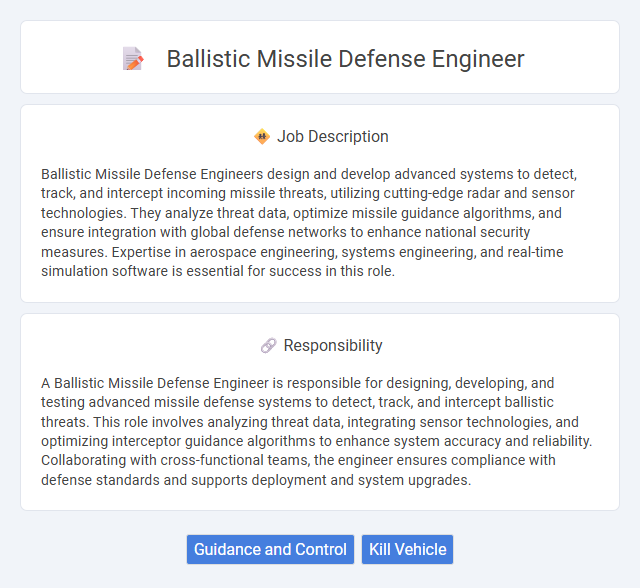
Ballistic Missile Defense Engineers design and develop advanced systems to detect, track, and intercept incoming missile threats, utilizing cutting-edge radar and sensor technologies. They analyze threat data, optimize missile guidance algorithms, and ensure integration with global defense networks to enhance national security measures. Expertise in aerospace engineering, systems engineering, and real-time simulation software is essential for success in this role.
Individuals with strong analytical skills and a background in aerospace or defense engineering are likely to be well-suited for a Ballistic Missile Defense Engineer role, where precision and problem-solving are crucial. Candidates who remain calm under pressure and can handle complex, high-stakes situations may have a higher probability of success in this demanding field. Those lacking technical expertise or the ability to work in fast-paced, mission-critical environments might find this job challenging to adapt to.
Qualification
A Ballistic Missile Defense Engineer must possess a strong foundation in aerospace, mechanical, or electrical engineering, typically holding a Bachelor's or higher degree in these fields. Expertise in missile defense systems, radar technology, and signal processing is essential, along with proficiency in simulation software and systems integration. Security clearance and experience with defense contracts or government projects enhance candidacy for this role.
Responsibility
A Ballistic Missile Defense Engineer is responsible for designing, developing, and testing advanced missile defense systems to detect, track, and intercept ballistic threats. This role involves analyzing threat data, integrating sensor technologies, and optimizing interceptor guidance algorithms to enhance system accuracy and reliability. Collaborating with cross-functional teams, the engineer ensures compliance with defense standards and supports deployment and system upgrades.
Benefit
Ballistic Missile Defense Engineers may experience significant career benefits including opportunities to work on cutting-edge technology that enhances national security. There is a high probability of job stability and competitive compensation due to the specialized nature of the field. Access to continuous professional development and collaboration with interdisciplinary teams could further advance their expertise and career growth.
Challenge
Ballistic Missile Defense Engineers likely face complex challenges involving the design and integration of advanced detection and interception systems against evolving missile threats. The role may require staying ahead of rapidly advancing technologies and adapting strategies to counter sophisticated missile capabilities. Probable obstacles include stringent accuracy requirements and real-time response constraints in high-stakes defense scenarios.
Career Advancement
Ballistic Missile Defense Engineers develop advanced missile detection and interception technologies, playing a critical role in national security systems. Career advancement often involves progressing to senior engineering positions, project management roles, or specialized research and development leadership within defense contractors or government agencies like the Missile Defense Agency (MDA). Professionals can also enhance their career trajectory through certifications in systems engineering, advanced degrees in aerospace or defense technology, and expertise in radar and sensor integration technologies.
Key Terms
Guidance and Control
A Ballistic Missile Defense Engineer specializing in Guidance and Control develops advanced algorithms to ensure precise targeting and interception of incoming threats. Expertise in sensor fusion, trajectory analysis, and real-time control systems is essential for optimizing missile accuracy and defensive response. Proficiency in software simulation tools and missile guidance technologies drives effective design and testing of robust missile defense solutions.
Kill Vehicle
A Ballistic Missile Defense Engineer specializing in Kill Vehicles designs and tests advanced interceptor components to ensure precise target engagement and destruction. Expertise in guidance systems, propulsion, and sensor integration is critical for optimizing Kill Vehicle performance against evolving missile threats. The role demands proficiency in simulation modeling, materials science, and real-time data analysis to enhance intercept accuracy and system reliability.
 kuljobs.com
kuljobs.com